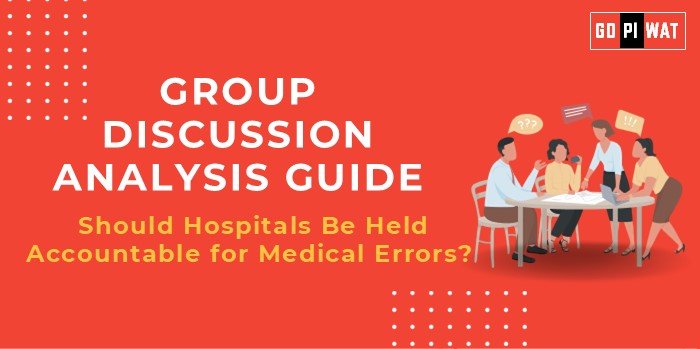📋 Group Discussion (GD) Analysis Guide: Should Hospitals Be Held Accountable for Medical Errors?
🌟 Introduction to the Topic
- Opening Context: Medical errors are among the leading causes of mortality worldwide, raising critical ethical, legal, and systemic questions. For B-school aspirants, the topic blends healthcare management, policy-making, and ethical decision-making.
- Background: The issue of medical accountability has gained traction with increasing reports of medical negligence globally and a growing demand for patient rights. High-profile cases, advancements in medical technologies, and healthcare reform debates underscore its importance.
📊 Quick Facts and Key Statistics
- 🌍 Global Medical Error Mortality: 2.6 million deaths annually, according to WHO (2022).
- 💰 Cost of Medical Errors: Estimated $20 billion annually in the U.S. alone (Johns Hopkins University).
- 🇮🇳 Indian Context: 5.2 million injuries annually attributed to medical errors (FICCI 2023).
- 📉 Patient Trust Index: 67% of Indians expressed distrust in the healthcare system post-COVID-19 (Gallup 2022).
🔗 Stakeholders and Their Roles
- 🏛️ Government: Regulatory oversight and ensuring public healthcare standards.
- 🏥 Hospitals: Implementation of safety protocols and training.
- 🩺 Medical Practitioners: Adhering to ethical practices and continuous education.
- 👥 Patients: Advocating for rights and accountability.
- ⚖️ Legal System: Establishing frameworks for compensation and accountability.
🏆 Achievements and Challenges
✨ Achievements:
- ✅ Patient Safety Initiatives: WHO’s Patient Safety Action Plan (2021-2030).
- 🤖 Technology Integration: AI-driven diagnostics reducing human error by 30% (JAMA 2023).
- ⚖️ Litigation Frameworks: Increased adoption of No-Fault Compensation Systems globally.
⚠️ Challenges:
- 📉 Systemic Gaps: High workload and burnout among healthcare workers leading to errors.
- 🔄 Accountability Blame Game: Difficulties in distinguishing systemic faults from individual negligence.
- 🌍 Global Comparison: Countries like Sweden excel in No-Fault Systems, while India struggles with legal delays.
Case Studies:
- 📂 AIIMS Incident (2022): Cyberattack exposed patient data, highlighting hospital vulnerabilities.
- 🇬🇧 UK NHS Safety Measures: Reduced preventable harm incidents by 7% (2023).
💡 Structured Arguments for Discussion
- Supporting Stance: “Hospitals must be accountable to ensure systemic checks and uphold patient trust.”
- Opposing Stance: “Accountability should consider systemic limitations and resource constraints.”
- Balanced Perspective: “Accountability frameworks should blend systemic and individual responsibility.”
🎯 Effective Discussion Approaches
- Opening Approaches:
- 📊 “With 2.6 million annual deaths globally due to medical errors, is healthcare losing its trust?”
- 📉 “India witnesses 5.2 million injuries annually due to medical negligence; accountability frameworks are overdue.”
- Counter-Argument Handling:
- 🌟 “While systemic gaps exist, hospitals must prioritize patient-centric reforms.”
📈 Strategic Analysis of Strengths and Weaknesses
- 💪 Strengths: Increased patient awareness, technology advancements.
- 🛑 Weaknesses: Resource constraints, legal bottlenecks.
- 🌟 Opportunities: AI adoption, global benchmarking of safety standards.
- ⚡ Threats: Rising malpractice claims, public distrust.
🎓 Connecting with B-School Applications
- 📌 Real-World Applications: Strategies for healthcare operations management and ethical decision-making.
- 🧐 Sample Interview Questions:
- 💬 “What role can technology play in reducing medical errors?”
- ⚖️ “How would you balance accountability with resource limitations in healthcare?”
- 💡 Insights for Students: Exploring healthcare financing models to support patient safety reforms.


